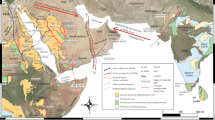Abstract
The main unusual feature of tectogenesis of the Asian–Pacific transition zone in the Mesozoic–Cenozoic consists in the formation of left-lateral strike-slip faults, which form the East Asian global shear zone with paragenesis of its constituent variously oriented fault systems. Paragenetic analysis has revealed that continental blocks of the Asian–Pacific transition zone were displaced along systems of transit left-lateral strike-slip faults of the East Asian global shear zone by hundreds of kilometers in the southerly to southwesterly direction due to tectonic activity of the Asian continent, which drifted southwestward. This process was accompanied by the formation of compression and extension structures. Otherwise, it is difficult to explain the structuring of the overhanging margin of the continent by subduction of oceanic lithospheric plates in the northerly to northwesterly direction opposite relative to the displacement of the continental crust as is usually thought.
Similar content being viewed by others
References
V. P. Utkin, Dokl. Akad. Nauk SSSR 240 2, 400–403 (1978).
J. W. Xu, G. Zhy, W. Tong, et al., Tectonophysics 134 4, 273–310 (1987).
B. A. Ivanov, Central Sikhote-Alin Fault (Dal’nevostochn. Kn. Izd., Vladivostok, 1972) [in Russian].
V. P. Utkin, Dokl. Akad. Nauk SSSR 229 4, 955–958 (1976).
V. P. Utkin, Geotektonika, No. 1, 73–87 (1985).
V. P. Utkin, “Wrench faults of Sikhote-Alin and accretionary and destructive types of fault dislocation in the Asia-Pacific transition zone,” in The Tancheng-Lujiang Wrench Fault System, Ed. by J. W. Xu (Wiley, Chichester, 1993), pp. 225–237.
V. P. Utkin, Russ. J. Pac. Geol. 7 3, 167–188 (2013).
The Tancheng-Lujiang Wrench Fault System, Ed. by J. W. Xu (Wiley, Chichester, 1993).
L. Aiming, M. Tokao, and W. Tianfeng, Tectonophysics 293, 85–104 (1998).
K. Otsuki, Isl. Arc 1, 51–63 (1992).
K. Kano and N. Matsushima, Mod. Geol. 12, 97–126 (1988).
H. Tanabe and K. Kano, Isl. Arc 5, 56–68 (1996).
S. Maruyama and T. Seno, Tectonophysics 127, 305–329 (1986).
K. Ichikawa, S. Mizutani, J. Hara, et al., Pre-Cretaceous Terrants of Japan (Nippon Insatsu Shuppan, Osaka, 1990).
V. P. Utkin, Sci. China 52 12, 1978–1992 (2009).
Author information
Authors and Affiliations
Corresponding author
Additional information
Original Russian Text © V.P. Utkin, 2016, published in Doklady Akademii Nauk, 2016, Vol. 467, No. 3, pp. 314–319.
Rights and permissions
About this article
Cite this article
Utkin, V.P. What is responsible for development of the Asian–Pacific transition zone: The geodynamics of oceanic plates or the Asian continent?. Dokl. Earth Sc. 467, 249–254 (2016). https://doi.org/10.1134/S1028334X16030223
Received:
Published:
Issue Date:
DOI: https://doi.org/10.1134/S1028334X16030223




